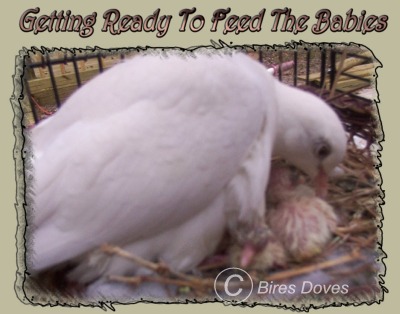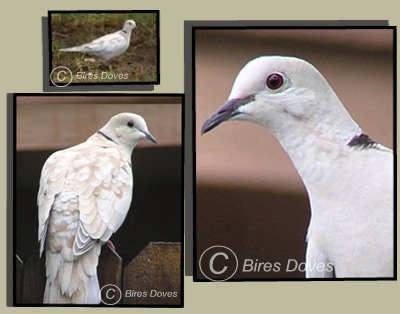|
Breeding/Reproduction:
Mourning Doves are easy to breed but they are rather flimsy nest builders, so it is best to provide them with an open nesting container
and some nesting materials. The female will lay two eggs which hatch
after about 13 days. The young will fledge in about 16 or 17 days
builders, so it is best to provide them with an open nesting container
and some nesting materials. The female will lay two eggs which hatch
after about 13 days. The young will fledge in about 16 or 17 days
Doves and pigeons have a very strong
reproductive drive and many will breed indoors. In general the tropic or
subtropic species are the easiest to breed. All the birds in this family
are monogamous, meaning they mate for life. However they will generally
take another mate if something happens to permanently remove the chosen
mate. Sometimes a male will kill his mate.
Sexing:
To breed you will need a sound compatible pair. Many doves and pigeons are not easily sexed though there are a few
species that are dimorphic, having distinctive markings differentiating
the male from the female. If the sex is not visually obvious, it can be
determined by either a surgical probe, endoscopy, which can be done
by many veterinarians or by a DNA testing, usually a blood sample or a
few plucked feathers sent to be diagnosed in a lab.
Many doves and pigeons are not easily sexed though there are a few
species that are dimorphic, having distinctive markings differentiating
the male from the female. If the sex is not visually obvious, it can be
determined by either a surgical probe, endoscopy, which can be done
by many veterinarians or by a DNA testing, usually a blood sample or a
few plucked feathers sent to be diagnosed in a lab.
Most breeders will keep young birds in a pen together until after the
first molt and let them pick their own mate. This usually works, though
sometimes what you think is a pair is two of the same sex. If a pair
lays three or more eggs, then you have two hens.
Nest:
These birds are noted for building rather flimsy nests. In the wild they
will construct a nest or platform using a few twigs, grasses, roots, and
maybe a few leaves. They will often build their nest on a rocky ledge or
in the branches of trees or shrubs, but sometimes they just use the old nest of others doves and pigeons or other birds. For many species
you can provide a nest platform or a shallow box, pan, or basket. For
the hole nesting birds provide a nest box. Nesting materials for the
smaller species can be such things as grass hay, coconut fibers, and
moss. For the larger species it can be twigs, pieces of willow, birch,
moss, and straw. Fill half the nest with material and put some on the
platform to encourage nesting. Both parents will help with the nest
building to some degree.
old nest of others doves and pigeons or other birds. For many species
you can provide a nest platform or a shallow box, pan, or basket. For
the hole nesting birds provide a nest box. Nesting materials for the
smaller species can be such things as grass hay, coconut fibers, and
moss. For the larger species it can be twigs, pieces of willow, birch,
moss, and straw. Fill half the nest with material and put some on the
platform to encourage nesting. Both parents will help with the nest
building to some degree.
Incubate:
The female will generally lay two eggs and both parents will incubate (though the female does most of it) for 13 to 19
days.There is usually one of each sex if both eggs hatch The hatchlings
are fed by both parents on a special food called 'crop milk' for the
first 4 or 5 days, and then the crop milk becomes mixed with more solid
food. Crop milk is a combination of partially digested food and a curd
like substance from the parents crop. The young will fledge in about 12
to 20 days. It is important to provide plenty of water for the parents
when they are feeding young.
parents will incubate (though the female does most of it) for 13 to 19
days.There is usually one of each sex if both eggs hatch The hatchlings
are fed by both parents on a special food called 'crop milk' for the
first 4 or 5 days, and then the crop milk becomes mixed with more solid
food. Crop milk is a combination of partially digested food and a curd
like substance from the parents crop. The young will fledge in about 12
to 20 days. It is important to provide plenty of water for the parents
when they are feeding young.
Difficulties:
There can be difficulties in breeding if the pair is very young. There are some species such as the Bleeding-heart Pigeon,
that are difficult to breed or may abandon their eggs or hatchlings. In
this case you can often successfully foster the eggs or young to other
birds that are not so particular about breeding and are good parents.
This can work if the eggs or hatchlings are within 4 or 5 days of the
foster parents own. You must also be sure they eat a similar diet and
that they are similar in size. Some very good foster parents include the
Barbary Dove, Diamond Dove, Senegal Dove, Spotted Dove and some of the
fancy pigeons.
very young. There are some species such as the Bleeding-heart Pigeon,
that are difficult to breed or may abandon their eggs or hatchlings. In
this case you can often successfully foster the eggs or young to other
birds that are not so particular about breeding and are good parents.
This can work if the eggs or hatchlings are within 4 or 5 days of the
foster parents own. You must also be sure they eat a similar diet and
that they are similar in size. Some very good foster parents include the
Barbary Dove, Diamond Dove, Senegal Dove, Spotted Dove and some of the
fancy pigeons.
Due to their very high reproductive drive, hybridization from
cross-breeding two species can happen in a community aviary. Be sure you
take precautions to keep the birds you want breeding within their own
species.
|